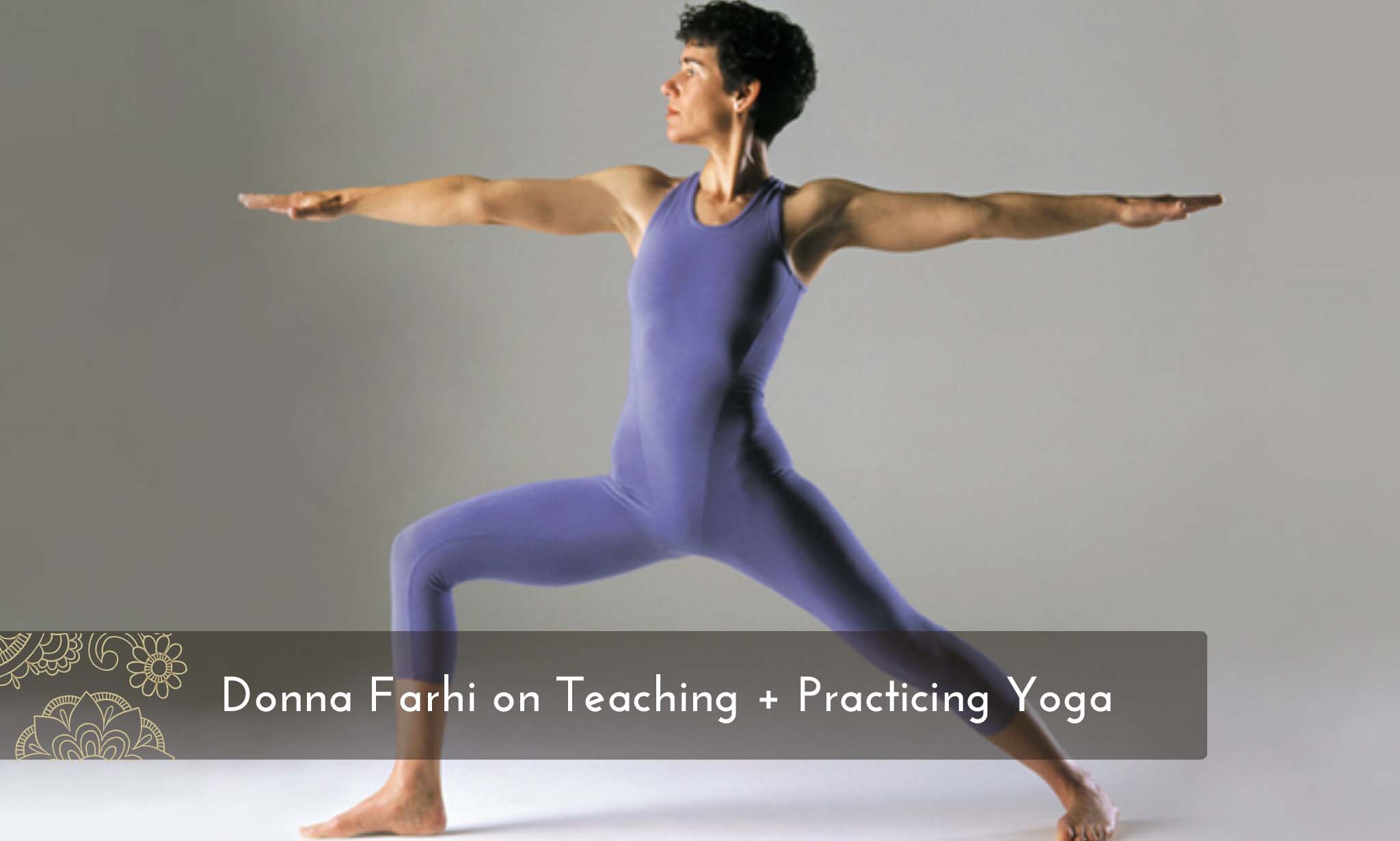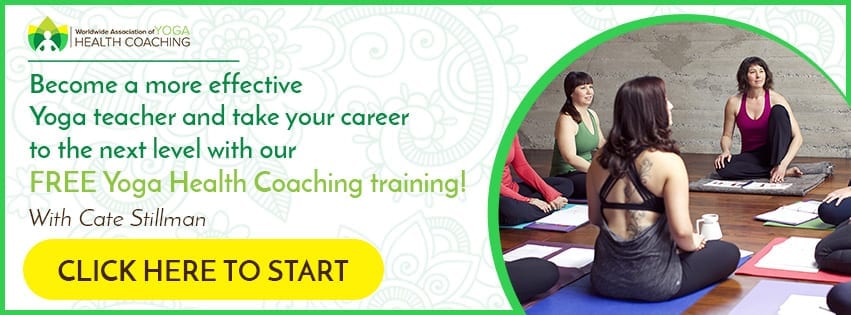Donna Farhi on Teaching + Practicing Yoga
“Each year I do a round-the-world teaching tour, so even though I live in New Zealand, I feel I have my finger on the pulse of issues percolating within the Yoga community. What I have been witnessing over the last decade is a growing chasm between yoga as a status seeking competitive form of physical elitism, and a veritable ground swell of both newbie and established practitioners seeking a return to Yoga as a practical, relevant, and accessible tool for self-care and self transformation.
People used to come to yoga to heal acute and chronic injuries and to sooth mental, emotional, and spiritual suffering. Increasingly, I work with people who have incurred their injuries THROUGH yoga, and feel enormous mental and emotional conflict within their practice because they sense the gap between what they intuitively know is right for themselves, and what the commercial yoga culture tells them they should be doing.
Increasingly I think people come to my intensives because I offer a Safe House for them to restore a loving relationship with themselves. Sadly, many share at the end of these intensives that they can’t go back to their teachers because to go back means to return to an atmosphere of coercion. Let’s open up a discussion about how teachers can support a shift back to self sovereignty for their students.”
-Donna Farhi
Donna Farhi, a yoga teacher who has been teaching since 1982, is truly a modern guru. She is the author of four contemporary yoga classics, and recently co-authored a book with Leila Stuart: Pathways to a Centered Body: Gentle Yoga Therapy for Core Stability, Healing Back Pain and Moving with Ease. She is one of the most sought-after guest teachers in the world, and leads intensives and teacher training programs internationally.
Donna brings us a greater perspective about the dynamics of Yoga teachers and students, and gives us insight into the differences between traditional yoga and commercialized yoga culture. Engaging in yoga should be a process of self-transformation that uses intuition and brings you in touch with your mind, body, and spirit. Unfortunately, much of the time the yoga we practice in our modern yoga culture actually takes us away from our inner reference system and leaves us feeling mechanical and out of rhythm with our bodies and our minds.
Improving Your Practice: Become a Better Yoga Teacher (And a Better Student)
In the commercialized yoga world, many teachers feel that in order to survive in their studios and in the yoga community, they have to teach in a way that goes against their own integrity. They feel they have to give their students a workout or teach them positions that they’ll be able to post on social media. And most teach their classes like another exercise class, with the teacher as the authority telling each student what to. But this takes them, and their students, far away from the purpose of yoga itself, which is a very personal journey.
As a yoga teacher, you can shift your practice and your teaching toward one which supports the self-sovereignty of your students. By following Donna’s advice, you can transform from a good yoga teacher to an exceptional one who helps students gain self-knowledge and self-awareness, achieve a cooperative relationship with their bodies, and have a more powerful yoga experience.
Advice for teachers to support their students’ shift back to self-sovereignty:
Use inquiry-based learning, as opposed to exercise-based learning.

Teacher guides student in yoga class
Exercise-based learning inherently puts the teacher in control of the student’s practice. It carries a predetermined outcome set by the teacher, where the student simply does or memorizes the motions. It assumes that everyone in the class is experiencing what the teacher wants them to experience, and adjusts all poses in the same way regardless of the individual student’s physical, mental, emotional, or energetic structure. Conversely, inquiry-based learning inherently puts the student in control of their own practice. It directs the student toward their own
inner reference system, and allows the student to determine their threshold.
Instead of telling students what to do next, pose it as a question. For example, instead of telling students to breathe in when they take their arms overhead, tell them to notice whether an inhalation supports that movement, or whether an exhalation does: already, the student is questioning what works best for their body and gaining more knowledge from the inside out.
Make agreements with your students
Before you begin teaching any yoga class or intensive, ask your students to make an agreement with you: acknowledge that they are there to use yoga to adapt to themselves, and that they don’t need to squeeze themselves into a preconceived, idolized notion of what yoga is. Make sure that everyone is on the same page that they listen to, trust, and follow their intuition. Then, if you offer a practice that the student feels is unsuitable for them, they can ask for an alternative and practice what they intuitively know is best for them. Maybe the timing isn’t working for them, maybe the breath isn’t in sync with their motion, maybe the poses aren’t the right modification. Ensure that each student knows they can ask your help to find a better practice for them.
Ask permission
It is common practice for yoga teachers to instruct a pose and then walk around and adjust their students as they see mistakes or misalignments. Often, they use students as examples for the rest of the class, to help them and help others. But by doing this, we take away a student’s self-sovereignty, and don’t allow them control over the situation. In order to allow the student to feel empowered during a class, you should ask permission before doing these things.
Some common questions to ask for permission:
- ‘May I touch you?’ Make sure the student feels free to answer yes or no honestly.
- ‘May I touch your lower abdomen?’ Be specific: the student may feel more comfortable with you touching some parts of their body than others.
- ‘Do you feel comfortable with me demonstrating this in front of the group?’ Ask them each time you want to demonstrate something with their body.
- ‘Do you feel comfortable with me sharing my perceptions of what is happening here?’
- ‘Would you be interested in trying something different?’ Instead of telling a student they are doing something wrong, help them find what is right for them. By allowing them control, they will be able to tell intuitively if something is amiss in their body.
Remember that advanced yoga is being completely who You Are.
Advanced yoga is not about mastering difficult poses, flowing for long periods of time, or flexibility. Rather, Donna being advanced in yoga is simply knowing who you are and practicing it wholeheartedly. Don’t pretend you’re something you’re not, and don’t apologize for who you are. By living as your true self, you have mastered advanced yoga, and will in turn be able to help your students to do the same.
Links:
About Donna
 Donna Farhi has been practicing Yoga for forty years, and teaching it since 1982. She is one of the most sought-after guest teachers in the world, leading intensives and teacher training programs internationally. Donna is the author of four contemporary classics: The Breathing Book, Yoga Mind, Body & Spirit: A Return to Wholeness and Bringing Yoga to Life: The Everyday Practice of Enlightened Living. Her fourth book Teaching Yoga: Exploring the Teacher-Student Relationship is a curricular text for teaching trainings worldwide. She has been profiled in four separate publications on exceptional contemporary teachers of our time, including Yogini: The Power of Women in Yoga. Her fifth book, co-authored with Leila Stuart, Pathways to a Centered Body: Gentle Yoga Therapy for Core Stability, Healing Back Pain and Moving with Ease, will be released in May, 2017. American born, Donna now resides in Christchurch, New Zealand on a 30-acre farm with her partner and her horses Santosha and Pavana.
Donna Farhi has been practicing Yoga for forty years, and teaching it since 1982. She is one of the most sought-after guest teachers in the world, leading intensives and teacher training programs internationally. Donna is the author of four contemporary classics: The Breathing Book, Yoga Mind, Body & Spirit: A Return to Wholeness and Bringing Yoga to Life: The Everyday Practice of Enlightened Living. Her fourth book Teaching Yoga: Exploring the Teacher-Student Relationship is a curricular text for teaching trainings worldwide. She has been profiled in four separate publications on exceptional contemporary teachers of our time, including Yogini: The Power of Women in Yoga. Her fifth book, co-authored with Leila Stuart, Pathways to a Centered Body: Gentle Yoga Therapy for Core Stability, Healing Back Pain and Moving with Ease, will be released in May, 2017. American born, Donna now resides in Christchurch, New Zealand on a 30-acre farm with her partner and her horses Santosha and Pavana.
You can listen to the original podcast episode here.


